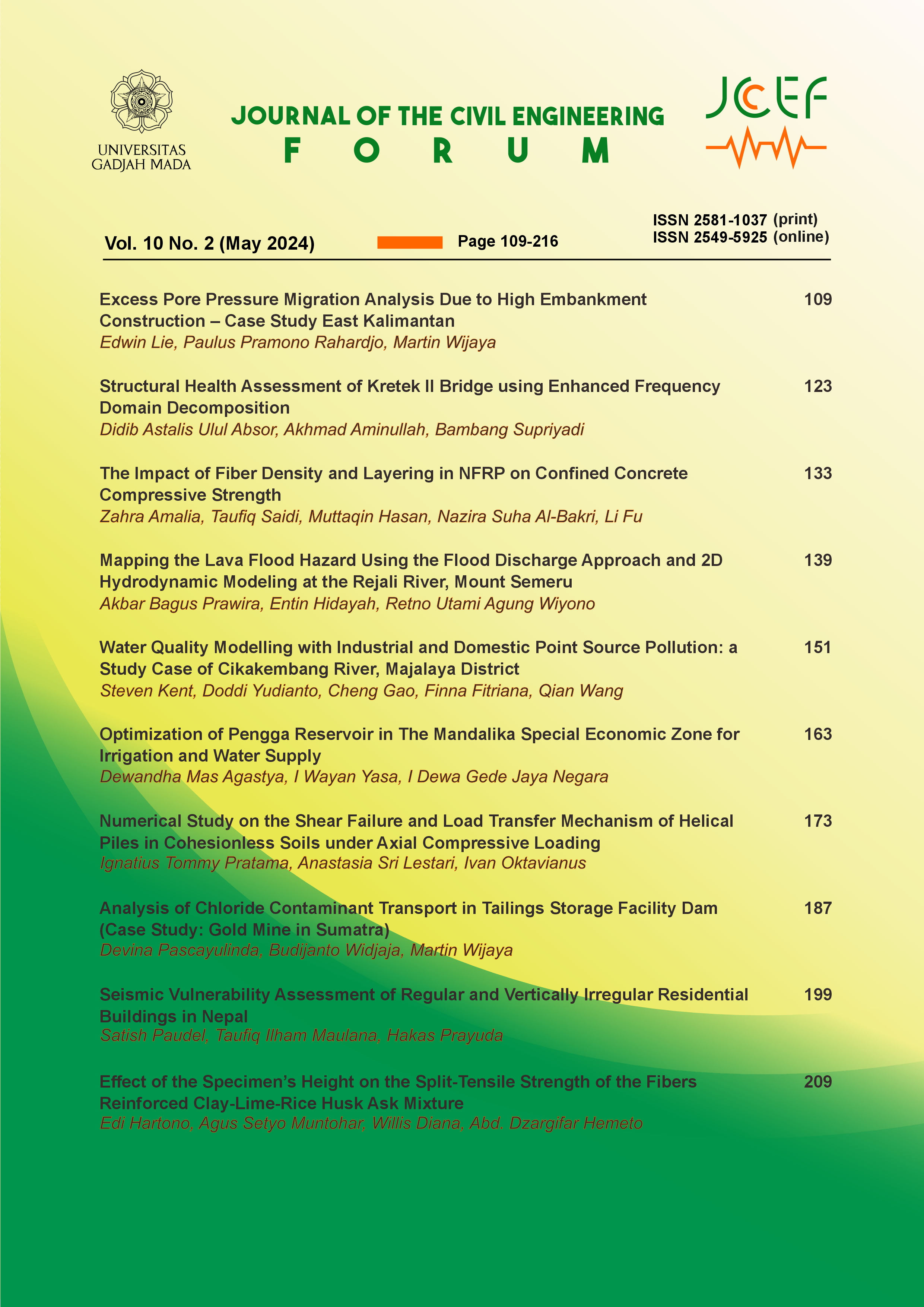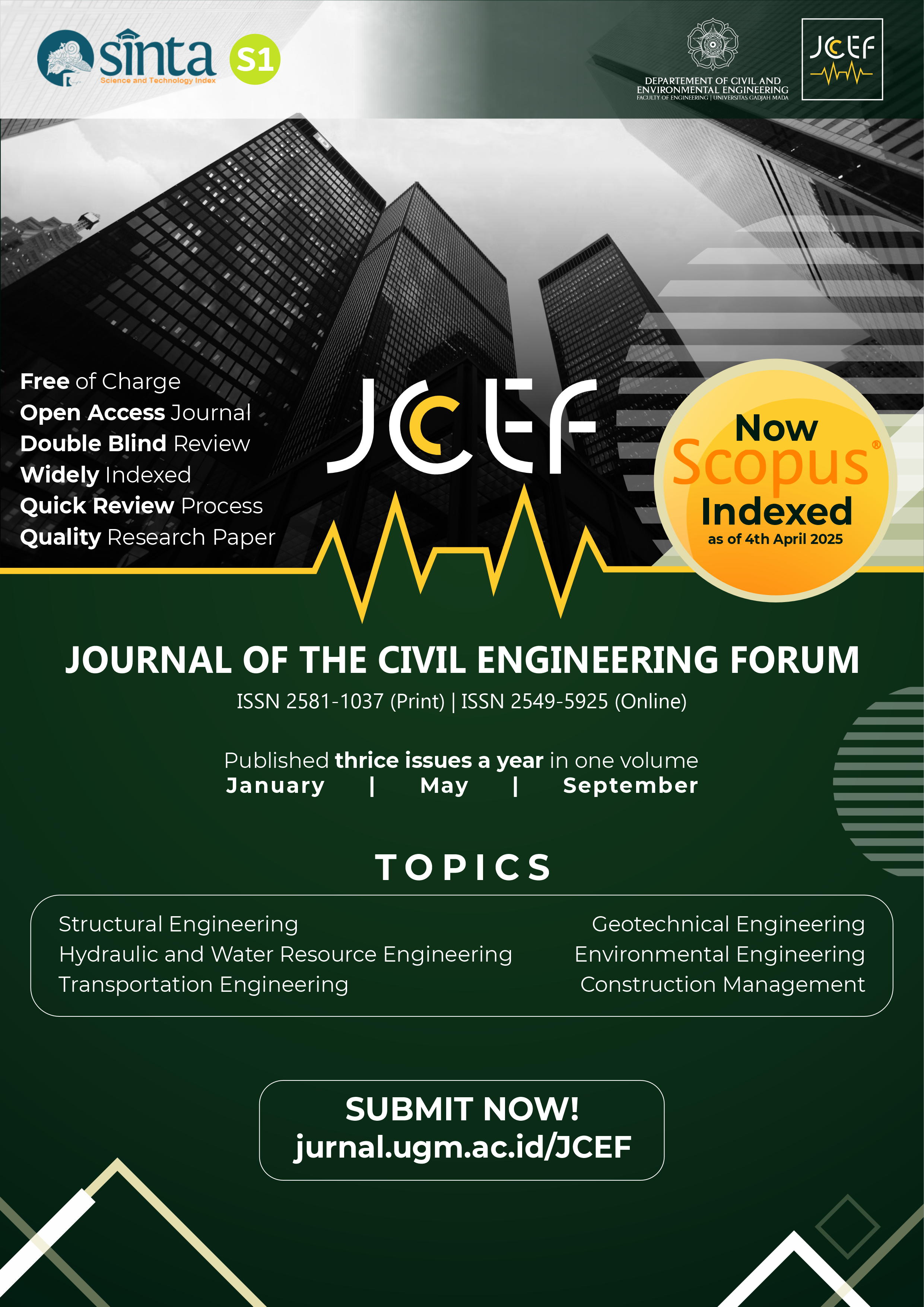Seismic Vulnerability Assessment of Regular and Vertically Irregular Residential Buildings in Nepal
Abstract
The need to assess the vulnerability of non-engineered residential RCC buildings in Nepal has become urgent, especially considering the ongoing modifications and additions to these structures without understanding their susceptibility to seismic events. Many residential buildings, particularly those up to three stories, did not fully comply to the guidelines outlined in Nepal Building Code NBC 105:2020. Therefore, there is a necessity to assess the seismic performance of these structures. This study aims to quantify the seismic vulnerability of such buildings by focusing on three distinct types: regular two and three-story structures, and irregular three-story structures. Using finite element modeling, the analysis of the buildings’ seismic capacity was performed through pushover analysis. Subsequently, linear time history analysis is conducted to determine the seismic demand. Two software were utilized to conduct the analyses, namely SAP2000 and STERA_3D. The study also includes the matching eleven strong ground motion inputs to Nepal’s site characteristics and response spectrum to ensure the relevance of the local context. Furthermore, fragility curves are constructed to compare the probability of structural failure, by first conducting the nonlinear dynamic analyses on the building specimens. The result showed that the probability of complete failure rises rapidly when an additional story is constructed with vertical irregularity, increasing from 1.8% to 5.7% in a non-engineered two-story building. The study also observes variations in top displacement across all three buildings due to differences in earthquake duration and frequency. From the findings, it is revealed that a significant increase in seismic vulnerability for vertically irregular buildings compared to regular ones
References
ACI, 2014. ACI 318 R-14: Building Code Requirements for Structural Concrete and Commentary on Building Code Requirements for Structural Concrete, American Concrete Institute, Texas, United States.
ATC, 1996. ATC 40: Seismic Evaluation and Retrofit of Concrete Buildings Redwood City California, Applied Technology Council, California, United States.
ASCE, 2016. ASCE 7-16:Minimum Design Loads and Associated Criteria for Buildings and Other Structures, American Society of Civil Engineers, Virginia, United States.
ASCE, 2017. ASCE 41-17: Seismic Evaluation and Retrofit of Existing Building, American Society of Civil Engineers, Virginia, United States.
Basukala, S. S. & Maskey, P. N., 2017. Seismic Vulnerability of Traditional Masonry Building: A Case Study of Byasi, Bhaktapur, Journal of Science and Engineering, 4, 24–30. URL: https://doi.org/10.3126/jsce.v4i0.22377
Bhusal, B., Aaqib, M., Paudel, S. and Parajuli, H. R. (2022), ‘Site specific seismic hazard analysis of monumental site Dharahara, Kathmandu, Nepal’, Geomatics, Natural Hazards and Risk 13(1), 2674–2696. URL: https://doi.org/10.1080/19475705.2022.2130109
Bhusal, B., & Paudel, S., 2021. Comparative study of existing and revised codal provisions adopted in Nepal for analysis and design of Reinforced concrete structure, International Journal of Advanced Engineering and Management, 6(1), 25–42.
Bhusal, B., Paudel, S., & Katuwal, T. B., 2020. Investigation of Confinement Effects for Determining Moment Curvature and Interaction Diagram of Reinforced Concrete Column, Technical Journal, 2(1), 81–88. URL: https://doi.org/10.3126/tj.v2i1.32844
Bhusal, B., Paudel, S., Tanapornraweekit, G., Maskey, P. N., & Tangtermsirikul, S., 2023. Seismic performance evaluation and strengthening of RC beam-column joints adopted in Nepal, Engineering Structures, 57, 105205. URL: https://doi.org/10.1016/j.istruc.2023.105205
Bhusal, B., Aaqib, M., Paudel, S., & Parajuli, H. R., 2022. Site specific seismic hazard analysis of monumental site Dharahara, Kathmandu, Nepal, Geomatics, Natural Hazards and Risk, 13(1), 2674–2696. URL: https://doi.org/10.1080/19475705.2022.2130109
FEMA, 2003. HAZUS-MH MR3: Multi-hazard Loss Estimation Methodology, Federal Emergency Management Agency, Washington, United States.
Gautam, D., and Rodrigues, H., 2018. Seismic vulnerability of vernacular Newari buildings in Nepal: observations and analysis of damage due to 1934, 1988, 2011, and 2015 earthquakes, Natural Hazard and Earth System Sciences. URL: https://doi.org/10.5194/nhess-2017-435
Giovinazzi, S., Lagomarsino, S., and Resemini, S., 2006. Displacement capacity of ancient structures through non-linear kinematic and dynamic analyses, Structural Analysis of Historical Constructions. URL: http://hdl.handle.net/10092/4127
Hancilar, U, Cakti, E., Erdik, M., Franco, G. E., & Deodatis, G., 2014. Earthquake vulnerability of school buildings: Probabilistic structural fragility analyses, Soil Dynamics and Earthquake Engineering, 67. 169-178. URL: https://doi.org/10.1016/j.soildyn.2014.09.005
Indian Standard, 2016. IS 1893-2016: Criteria for Earthquake Resistant Design of Structures, Bureau of Indian Standards, New Delhi, India.
Indian Standard, 1993. IS 13920: Ductile Design and Detailing of Reinforced Concrete Structures Subjected to Seismic Force, Bureau of Indian Standards, New Delhi, India.
Kiyono, J., Furukawa, A., Parajuli, H. R., Maskey, P. N., & Parajuli, R. R., 2017. Vulnerability Assessment of Historical Structures in Kathmandu, Nepal, 16th World Conference on Earthquake, Santiago, Chile.
Lumantarna, E., Griffith, M. C., Vaculik, J., & Lam, N., 2006. Seismic Fragility Curves for Unreinforced Masonry Walls, Earthquake Engineering in Australia, Canberra, Australia. URL: https://hdl.handle.net/2440/35875
Motra, G. B., & Paudel, S., 2021. Performance evaluation of strengthening options for institutional brick masonry buildings: A case study of Pulchowk Campus, Progress in Disaster Science, 10, 100173. URL: https://doi.org/10.1016/j.pdisas.2021.100173
MoUD, 2020. Seismic Design of Buildings in Nepal, Ministry of Urban Development, Kathmandu, Nepal.
NBC, 1994a. NBC 105-1994: Seismic Design of Building in Nepal, Nepal National Building Code, Kathmandu, Nepal.
NBC, 1994b. NBC 205-1994: Mandatory Rules of Thumb Reinforced Concrete Buildings Without Masonry Infill, Nepal National Building Code, Kathmandu, Nepal.
NBC, 2012. NBC 205-2012: Mandatory Rules of Thumb Reinforced Concrete Buildings Without Masonry Infill, Nepal National Building Code, Kathmandu, Nepal.
NBC, 2020. NBC 105-2020: Seismic Design of Building in Nepal, Nepal National Building Code, Kathmandu, Nepal.
NPC, 2015. Nepal Earthquake 2015: Post Desaster Needs Assessment, Kathmandu, Nepal.
Parajuli, H. R., Bhusal, B., & Paudel, S., 2021. Seismic zonation of Nepal using probabilistic seismic hazard analysis, Arabian Journal of Geosciences, 14, 2090. URL: https://doi.org/10.1007/s12517-021-08475-4
Paudel, S. (2023), Investigation of modelling approaches to study the structural performance of 3D printed plain wall under uniform axial compression’. Advances in Structural Engineering 26(10), 1911–1928. URL: https://doi.org/10.1177/13694332231166566
Paudel, S., & Bhusal, B., 2021. Investigation of Modelling Approaches for Non-Linear Analysis of Reinforced Concrete Frames. Journal of Engineering Science & Technology Review, 14(2), 61-72. URL: https://doi.org/10.25103/jestr.142.09
Paudel, S., Tanapornraweekit, G., & Tangtermsirikul, S. (2022a). Numerical investigation of concrete filled hollow precast composite columns subjected to lateral cyclic loading. Engineering Structures,252, 113586. URL: https://doi.org/10.1016/j.engstruct.2021.113586
Paudel, S., Tanapornraweekit, G., & Tangtermsirikul, S. (2022b). Numerical study on seismic performance improvement of composite wide beam-column interior joints. Journal of Building Engineering, 46, 103637. URL: https://doi.org/10.1016/j.jobe.2021.103637
Saito, T. (2020), STERA 3D: Structural Earthquake Response Analysis D, Vol. 3, Toyohasi, Japan.
Shrestha, S., Shrestha, B., Shakya, M. and Maskey, P. N. (2017), ‘Damage assessment of cultural heritages in Nepal after 2015 Gorkha earthquake: A case study of Jagannath Temple’, Earthquake Spectra 33(1), 363–376. URL: https://doi.org/10.1193/121616eqs241m
Tanapornraweekit, G., Jiramarootapong, P., Paudel, S., Tangtermsirikul, S., & Snguanyat, C. (2022). Experimental and numerical investigation of 3D-printed mortar walls under uniform axial compression. Construction and Building Materials, 360, 129552. https://doi.org/10.1016/j.conbuildmat.2022.129552
TEC, 2007. TEC 2007: Turkish Earthquake Design Code TEC 2007, Turkish Republic the Ministry of Public Works and Settlement, Ankara, Turkey.
USGS, 2021. "https://www.usgs.gov/natural-hazards/earthquake-hazards/earthquakes."
World Bank, 2017. Climbing Higher: Toward A Middle Income Nepal, World Bank Group.
Copyright (c) 2024 The Author(s)

This work is licensed under a Creative Commons Attribution-ShareAlike 4.0 International License.
Copyright is granted to authors for the purpose of providing protection for articles written to describe experiments and their results. JCEF will protect and defend the work and reputation of the author and are also willing to address any allegations of violation, plagiarism, fraud, etc. against articles written and published by JCEF. JCEF is published under the terms of the Creative Commons Attribution-ShareAlike 4.0 International License (CC BY-SA 4.0). The author holds the copyright and assigns the journal rights to the first publication (online and print) of the work simultaneously.





